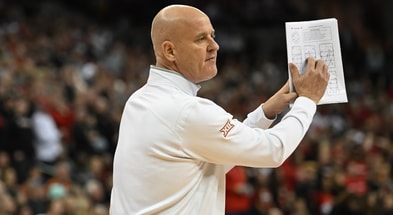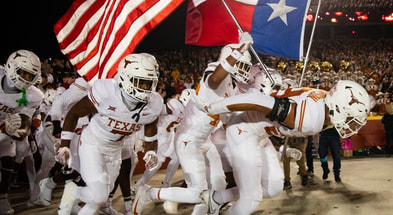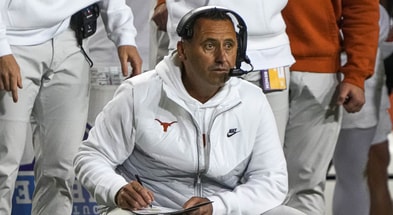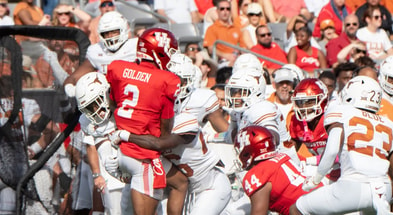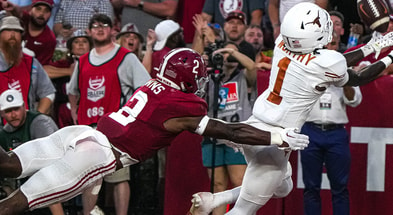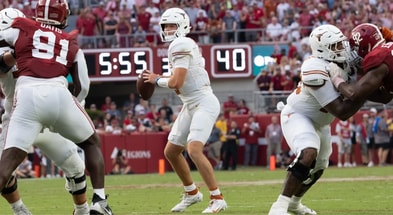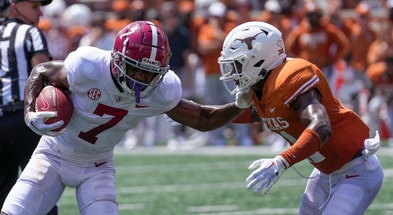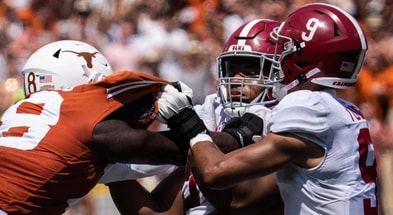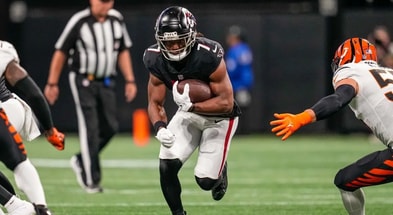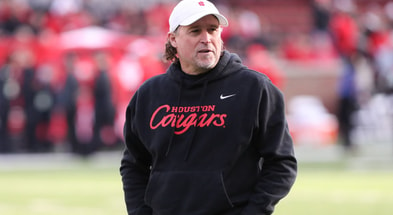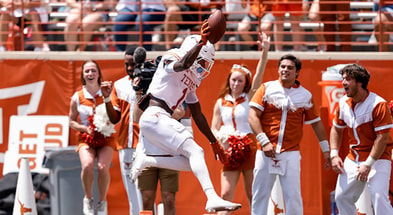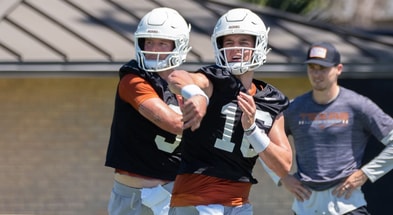Gameplan: Personnel decisions for Steve Sarkisian
We’re going to see more personnel diversity from the Texas offense under Steve Sarkisian’s guidance than under Tom Herman. While Texas ran a number of different formations under Herman, the name of the game was having as much formational diversity as possible while remaining in 11 personnel (one running back, one tight end). So long as Texas stayed in 11 personnel they could move at tempo and punish defenses for their own personnel choices. Opponents that wanted to load up against the run would face spread sets with a flex tight end. Defenses matching with lighter personnel could face condensed power sets and quarterback runs.
Sarkisian’s starting point is 12 personnel (one running back, two tight ends) but will also certainly include 11 personnel, 20 personnel (two running backs, no tight ends), and likely 21 personnel (two running backs, one tight end). Sark prefers to throw a lot at defenses and hunt matchups with motion and multiplicity. So we’ll see some of everything, but Sark will have some choices to make about which are strongest and which to put the most emphasis on.
To some degree this will come down to whether the offense gets more from having Jared Wiley, Xavier Worthy, or Keilan Robinson/Roschon Johnson on the field. Ultimately, it will come down to playing to the quarterback’s strengths.
The base, 12 personnel offense
Texas has a lot of tight ends on this team who are effective receivers, but for 12 personnel to really work they need guys who are also good blockers. Jared Wiley, Brayden Liebrock, Juan Davis, Ja’Tavion Sanders may all be good receivers but unless they force defenses into run-stopping personnel and calls, unless they can help protect the quarterback when it’s time for play-action, unless they help present additional threats in the run game it’s hard for them to offer more than a third receiver would. Remember, the name of the game is setting up Bijan Robinson.
If they can block? It opens up the offense in a few important ways. One important boost they can add is in blocking some of the nasty defensive ends around the league. Oklahoma, TCU, and Iowa State all have really good defensive ends they can send over the edge along with linebackers who are serious threats as blitzers. Life gets easier on offense if you can help the offensive tackles from getting whipped around the edge with a chip or double team. It’s also easier to get double teams across the front for duo/inside zone if you have more bodies in the box, or you can run gap schemes on the edge at smaller defenders.
Sark’s favorite mesh route concepts are also doubly effective if the tight ends are packed in and the defense is trying to match with man coverage and/or getting bigger linebackers on the field. Sending Cade Brewer and Jared Wiley across the formation on shallow crossing routes is hazardous for opponents trying to chase a Joshua Moore or Jordan Whittington and the Texas tight ends can certainly catch the ball in their own right.
The fan favorite, 20 personnel
While it makes sense for Texas to have 20 personnel to mix in, I doubt it’s as prominent or quite as impactful as fans would like for it to be. The problem with putting two running backs on the field at the same time is that only one of them can be a running back on a given play, the other guy has to have something productive to do and it has to be something he can do from the backfield. Blocking is the obvious assignment, but none of these guys are likely to be great blockers and certainly not better blockers than Cade Brewer would be as an H-back.
Still, all of them are versatile, can catch the ball, and are among the best skill athletes on the team with the ball in their hands. We don’t know exactly what Sark might cook up from 20 personnel but you could venture a guess it would be heavy on misdirection, screens, and some nasty passing concepts aiming to confuse linebackers and isolate Bijan Robinson in favorable matchups.
One of my favorite hypothetical 20 personnel plays is mesh with running backs running wheel routes in either direction to confuse the defense on the actual pattern.
There’s a lot there for those linebackers to track and the upshot is likely to be receivers getting wide open in the middle of the field when they can’t process it all and match the right routes with the right timing.
In the run game one of the best ways to use 20 personnel is with split outside zone, as Oklahoma normally does:
Again, this is tricky for the linebackers because if they key the backs, it gives them cross flow, and if they hesitate they can be lined up by the offensive line. If both backs are capable of going against the flow and trapping or cutting the backside edge defender, you can run the play to either direction without tipping anything to the defense before the snap. The Sooners have been using this very effectively for the last few years and once it’s established, you can throw to the blocking back releasing into the flat on play-action or an RPO.
11 personnel, a quarterback’s choice
When in 12 personnel, RPOs can be a nasty addition to the offense but they aren’t as essential to guaranteeing a clear box for the run game. With five offensive linemen and two tight ends, the offense can block the front seven and if the defense brings an eighth the most efficient way to punish him isn’t RPOs but over the top with play-action. In 12 personnel RPOs are better for getting easy gains to a top receiver when he gets 1-on-1 coverage. SMU with Shane Buechele and James Proche were great at using 12 personnel to get Proche open outside 1-on-1 while everyone else was executing a run play.
In 11 personnel the spread run game becomes a chess match between the quarterback and the secondary. They try to sneak a seventh defender in or near the box and the quarterback looks to either hold them back or punish their aggressiveness with RPO shots to his receivers. Rather than getting all the right calls and combinations up front on offense, you’re looking to clear things out so it’s six-on-six with the seventh guy having to close and tackle the running back in space.
But for Texas to rely heavily on 11 personnel, they need at least three receivers who are worthy of seeing the field regularly and ideally five or six to allow for some rotations or injury insurance. To execute the RPO offense you need receivers who can be counted on to be in the right spots at the right time, making the right reads of the defense and getting open in 1-on-1 matchups as needed. Xavier Worthy’s breakout fall camp has been huge for Texas here, giving them options to rely more on 11 personnel should the tight ends not be as effective in the blocking game as you’d like.
Ultimately the best way to clear out running space in the box for Bijan Robinson is to hold defenders out in space with the threat of the pass. Steady gains are easier when you can isolate a Big 12 defensive front against the line. Bigger formations are often better for generating long runs by piling up defenders close so a breakaway run doesn’t have to clear as many second and third level defenders.
The quarterback has to be ready to read the defense though and control them on behalf of the running back. The offensive coordinator has more control when it’s in 12 personnel, in 11 you need the dynamism of the RPO game to keep things moving.
Thus far it appears Texas will have the skill personnel to potentially make any of these sets work, so whether they lean heavily into one or another may be more an indication of which quarterback is on the field and their relative strengths and weaknesses. The challenge for Sark will be the following, plausible scenario.
Casey Thompson running scripted plays in 12 personnel is the more game-ready option. It sets up Bijan to deal out damage and makes it easy for Sark to line up his best receivers as a result for scripted shot plays. However, the tight ends aren’t good enough in the blocking game to beat top defenses. Meanwhile Hudson Card can execute the RPO game from 11 personnel more effectively but still has a more limited grasp of all the concepts Sark would like to use. In that event, assuming turnovers aren’t a negative factor, I’d expect Card to get the nod so the offense could grow over the course of the season to develop enough arrows in the quiver to take on the better opponents in Big 12 play. Ultimately the measure of a quarterback is how well he involves his teammates to create an overall offense. The overall offense for the 2021 Longhorns is just now starting to come into sharper focus.
Cover photo by Will Gallagher for Inside Texas
